Dallas County Reports 947 New COVID-19 Cases, 17 Deaths
As local officials warn COVID-19 cases are expected to continue rising and they look warily toward the upcoming Thanksgiving holiday, but news about vaccine candidates looks promising, here’s what you need to know today:
- Dallas County reports 947 new COVID-19 cases, 17 more deaths;
- Pfizer: Request planned as data shows vaccine candidate 95% effective;
- Abbott, TEA, TDEM announce $420 million reimbursement program for Texas schools.
Dallas County Reports 947 New COVID-19 Cases, 17 More Deaths
Dallas County Health and Human Services Wednesday announced 947 more positive COVID-19 cases — 786 confirmed and 161 probable — and 17 more deaths.
The county’s reported a cumulative total of 111,960 confirmed cases and 1,162 confirmed deaths, and a cumulative total of 10,347 probable cases and 22 probable deaths.
The additional deaths reported Wednesday include a Dallas woman in her 30s who was post partum, a Dallas man in his 40s, a Mesquite woman in her 50s, two Dallas women in their 50s, a Garland man in his 50s, three Dallas men in their 60s, a Farmers Branch man in his 60s, a Dallas woman in her 60s, a Dallas man in his 60s who didn’t have underlying conditions, a Dallas man in his 70s, a Dallas woman in her 70s, a Lancaster woman in her 70s who died in a hospital emergency room, a Richardson woman in her 80s, and a Dallas man in his 80s. Unless otherwise noted, each had underlying health conditions.
Of the total confirmed deaths reported to date, about 24% have been associated with long-term care facilities.
“Today, for the second day in a row, Dallas County reports under 1,000 new COVID cases but I caution because these numbers appear to still be low due to lower than expected numbers from the state’s electronic laboratory reporting system,” Dallas County Judge Clay Jenkins said. “For the CDC week ending November 7, our average daily case count is above 1,000, up almost 300 cases more from the week before. I am pleased with what I’m seeing on flash polls on the news and as I talk to people, that they are getting the message to strengthen their resolve and limit their contacts with people outside the home.”
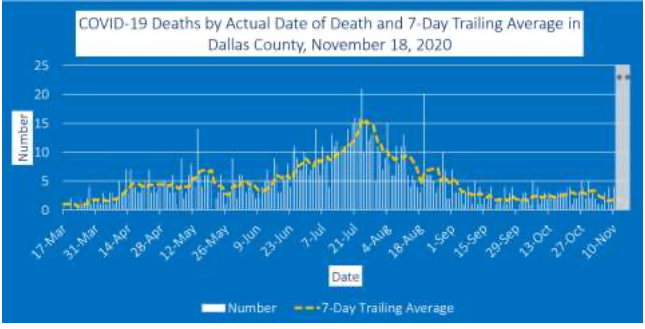
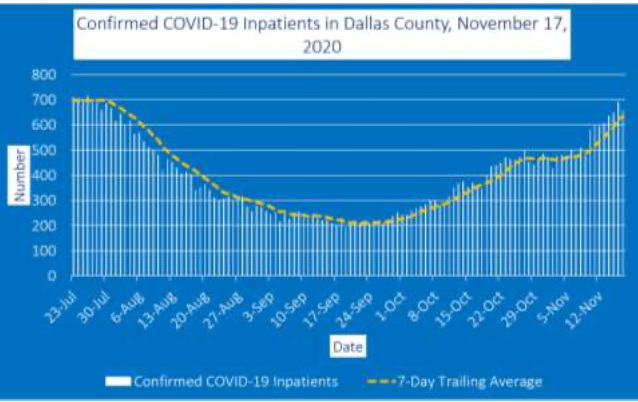
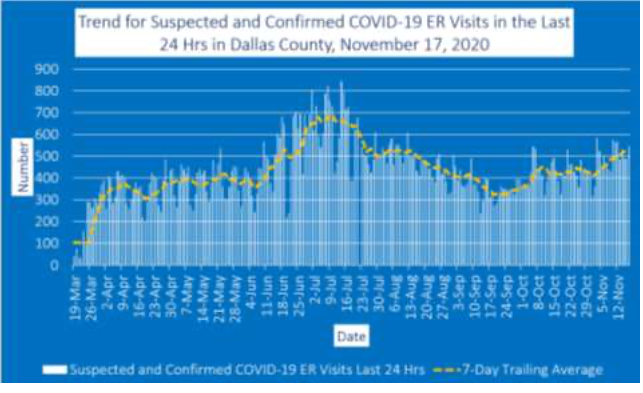
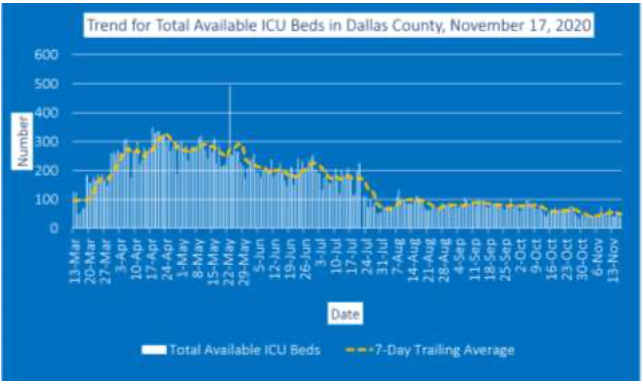
The county reported 660 COVID-19 patients in acute care Tuesday, and the number of emergency room visits for COVID-19 like symptoms in Dallas County was 545 for the same time-period, which represents around 20 percent of all emergency department visits in the county according to information reported to the North Central Texas Trauma Regional Advisory Council.
Additionally, the percentage of respiratory specimens testing positive for the virus that causes COVID-19 remains high, with 15.3% of symptomatic patients presenting to area hospitals testing positive in the week ending Nov. 7.
Of all confirmed cases requiring hospitalization to date, more than two-thirds have been under 65 years of age.
A provisional total of 919 confirmed and probable COVID-19 cases were diagnosed in school-aged children (5 to 17 years) during the week ending Nov. 7, a three-fold increase from five weeks earlier.
During the week ending Nov. 7, 10 K-12 schools in Dallas County initiated temporary closures of their campuses to in-person instruction because of COVID-19 cases.
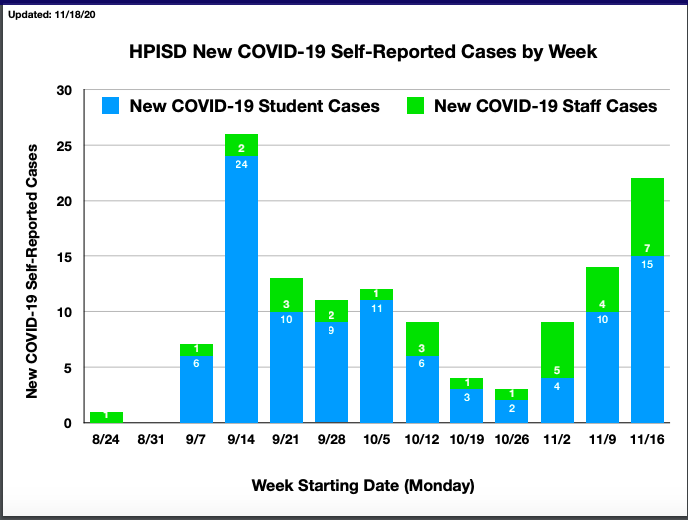
As of Wednesday, Highland Park ISD reported one case among a staff member assigned to Armstrong Elementary and one case in a student there, one case in a student at Boone, three cases among students at Bradfield, one case among a staff member assigned to Hyer, two among students there, one among a student at University Park, two cases among staff members assigned to McCulloch Intermediate, four among students there, three cases among staff members assigned to Highland Park Middle School and three among students, two cases among staff members assigned to Highland Park High School and five among students, according to their COVID webpage.
As of Wednesday, Dallas ISD reported 1,123 cases districtwide, 460 among campus staff, 112 among central staff, and 551 among students, according to the district’s COVID dashboard.
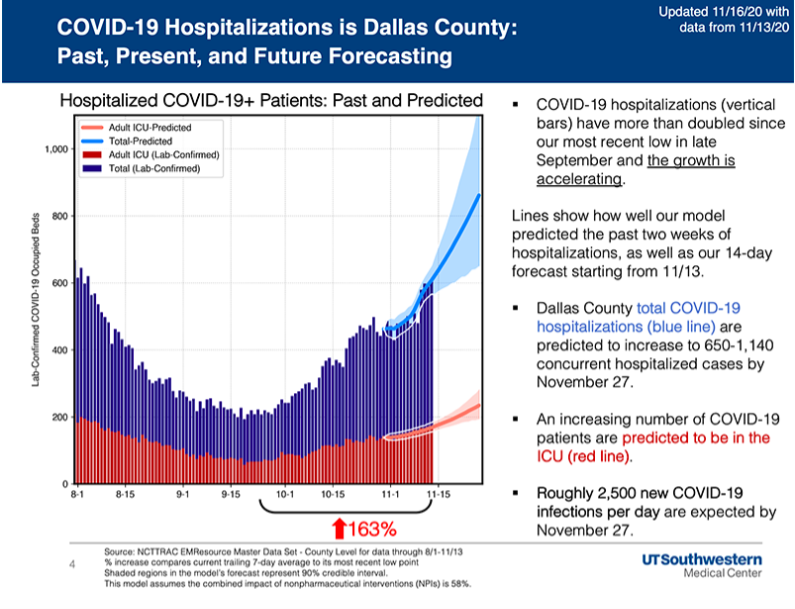
UT Southwestern Medical Center’s model projects total COVID-19 hospitalizations could increase to between 650 and 1,140 concurrent hospitalized cases by Nov. 27 and roughly 2,500 new COVID-19 infections per day are expected by Nov. 27.
Pfizer: Request Planned As Data Shows Vaccine Candidate 95% Effective

Pfizer announced Wednesday that a final analysis of clinical trial data showed its COVID-19 vaccine candidate was 95% effective.
Pfizer and BioNTech also announced the safety milestone required by the U.S. Food and Drug Administration (FDA) for Emergency Use Authorization (EUA) has been achieved. Pfizer and BioNTech plan to submit a request within days to the FDA for an EUA based on the totality of safety and efficacy data collected to date, as well as manufacturing data relating to the quality and consistency of the vaccine.
These data also will be submitted to other regulatory agencies around the world.
“The study results mark an important step in this historic eight-month journey to bring forward a vaccine capable of helping to end this devastating pandemic. We continue to move at the speed of science to compile all the data collected thus far and share with regulators around the world,” said Dr. Albert Bourla, Pfizer chairman and CEO. “With hundreds of thousands of people around the globe infected every day, we urgently need to get a safe and effective vaccine to the world.”
The companies’ data shows 170 study participants contracted COVID-19–eight among those who were vaccinated, and 162 in the placebo group.
The vaccine also helped prevent severe cases of the disease, according to the data, with nine of 10 severe cases occurring in the placebo group.
The efficacy in adults over 65 was also over 94%, according to the data.
The study also showed most who received the vaccine tolerated it well. The only severe side effect reported was fatigue in 3.8% of participants and headache in 2% after the second dose.
The news follows earlier encouraging news about the efficacy of Pfizer’s vaccine candidate, as well as promising news about Moderna’s vaccine candidate earlier this week.
State Announces $420 Million Reimbursement Program
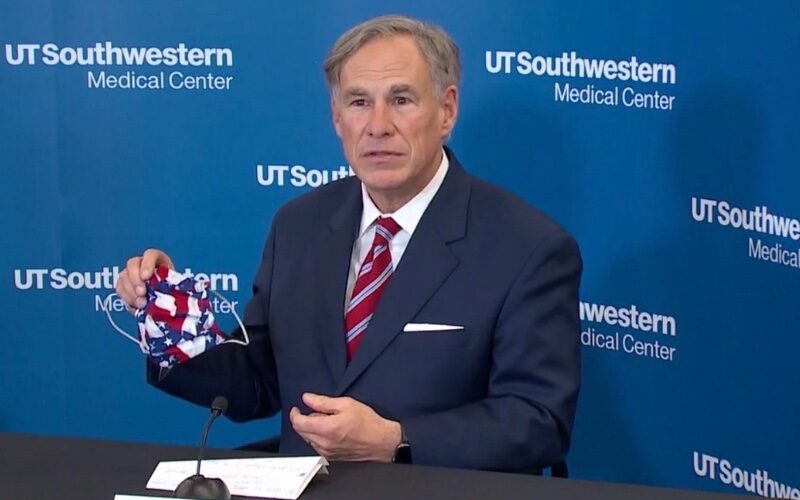
Gov. Greg Abbott Wednesday announced a $420 million reimbursement program to cover costs incurred by Texas public schools that purchased Wi-Fi hotspots and/or eLearning devices (such as laptops, tablets, and Chromebooks) so students could learn remotely during the COVID-19 pandemic.
The program, jointly administered by the Texas Education Agency (TEA) and the Texas Division of Emergency Management (TDEM) using federal CARES Act dollars, will reimburse districts for costs incurred since the 2019-20 school year if the district locally purchased eLearning devices and/or WiFi hotspots. This reimbursement program builds on the progress made by Operation Connectivity, announced by Governor Abbott in May as an initiative to close the digital divide in Texas.
“Thanks to the collaborative approach of Operation Connectivity, students across the state have access to the eLearning resources they need to stay connected and receive a quality education through remote learning,” said Abbott. “This reimbursement program will significantly ease the financial burden on Texas public schools that have purchased these crucial eLearning devices and also helps ensure that more students have access to these devices as needed.”
TDEM has already reimbursed school systems that purchased technology in response to the pandemic during the final months of the 2019-20 school year. Additionally, TEA directly purchased roughly 1 million eLearning devices and WiFi hotspots this summer, distributing the technology directly to Texas schools.
Since the start of Operation Connectivity, schools in Texas have acquired more than 2 million eLearning devices (such as laptops, tablets, Chromebooks) and more than 800,000 WiFi hotspots — totaling 2.8 million devices and hotspots combined and counting. Devices have been directly purchased by the state, purchased by school systems, donated by corporate partners, and in some cases, procured with the help of city and county governments leveraging federal CARES Act Coronavirus Relief Fund (CRF) dollars. With this program, the State of Texas has allocated more than $780 million in CARES Act funding for public education to assist local education agencies in connectivity purchases and reimbursement for COVID-19 expenses.
School systems across Texas may apply for these reimbursement funds beginning Friday, Nov. 20. TEA will be holding a webinar that day, during which time details of the application process will be provided to participants.
“Throughout the pandemic we have maintained full funding for our schools, including the increased funds provided by House Bill 3, so that our students don’t fall behind as we fight the coronavirus. Schools have established a wide-range of remote learning programs and have made laptops, tablets and WiFi hotspots available to students who need them to remain on track. This $420 million in federal CARES Act funding for Operation Connectivity, along with the $362 million in federal CARES Act funding that we have already provided, will ensure our schools — particularly in rural areas — remain on the cutting edge during the pandemic,” said Lt. Gov. Dan Patrick.
“The State and local school districts are partners in public education, and this reimbursement program will provide needed resources for schools who are struggling with unanticipated connectivity costs as they transitioned to a digital learning environment for students during the pandemic,” said House Speaker Dennis Bonnen.
“Texas is working on several fronts to support our local school districts amid the COVID-19 pandemic. This financial support will help students, parents and teachers overcome the challenges presented by remote learning as we continue working to bridge the digital divide,” said Senate Finance Committee Chairman Jane Nelson.
“While we all wish all our students could be learning in the classroom right now, we recognize that is not possible at this time. However, this cannot be a cause for different learning outcomes due to different levels of access to technology. I support the Governor taking this action to help ensure all of our students have the resources they need to learn until a return to the classroom is possible,” said Senate Finance Committee Vice Chairman Juan “Chuy” Hinojosa.
“This pandemic has amplified disparities in access to broadband and brought them to the forefront. Together with our local education leaders, we have taken this challenge head on. With this investment we are one step closer to closing the digital divide and providing our educators with the necessary tools to ensure all children in Texas receive a high quality education. I want to thank Gov. Abbott and my colleagues for prioritizing this effort,” said House Appropriations Committee Chairman Giovanni Capriglione.
“Amid the COVID-19 pandemic, many students lacked the necessary tools to adapt to distance learning,” said Rep. Longoria. “School districts that addressed this by purchasing essential devices can apply for reimbursement,” said House Appropriations Committee Vice Chairman Oscar Longoria.









